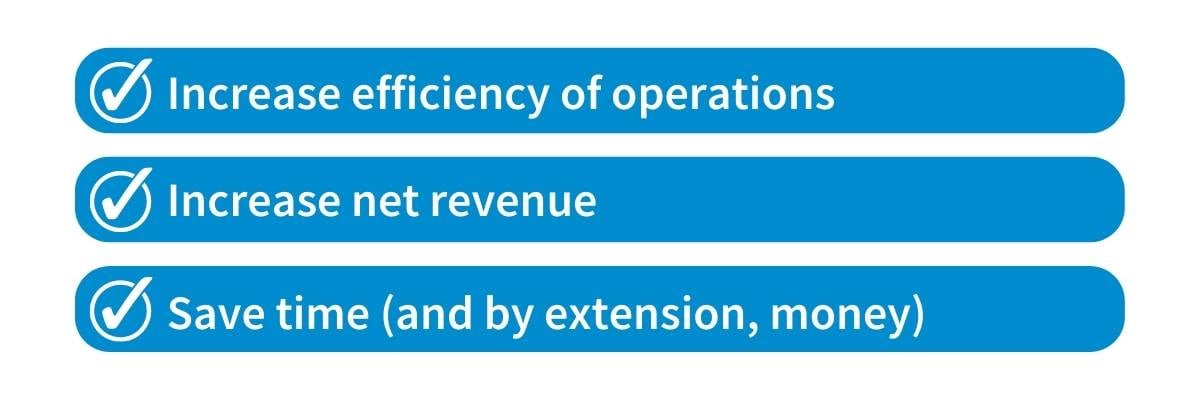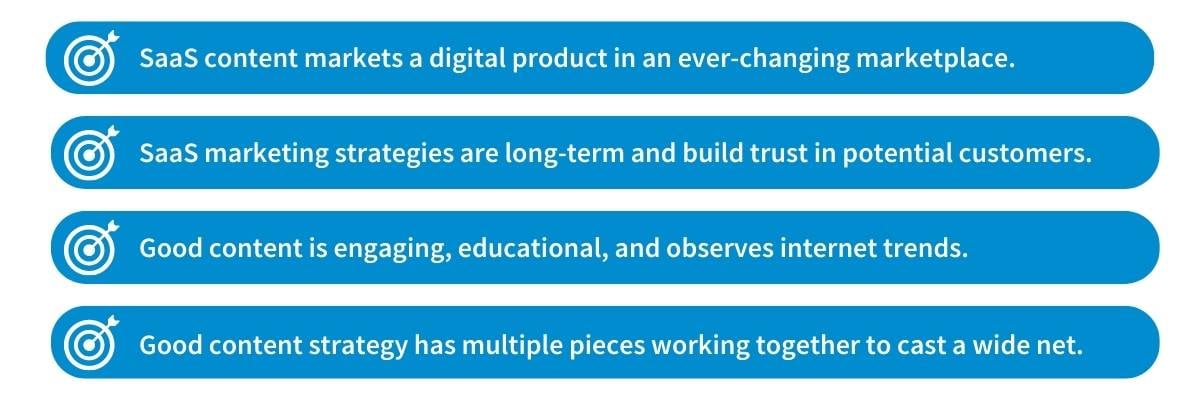Creating high-quality, engaging Software-as-a-Service (SaaS) content is no simple endeavor. Marketing digital products, in general, is different from physical products, but SaaS is even more unique because software is constantly changing. These factors can make a solid SaaS content strategy seem elusive, or even impossible. The good news is that with a little bit of planning and just a few key concepts, it’s far easier than it appears.
If you’re struggling with content for your SaaS company, look no further. Below, we’ll examine what makes SaaS marketing unique, content marketing best practices, and even some starting points for how to write SaaS content. By the time you finish reading this piece, you’ll be your own SaaS idea generator for content!
Why Is Content Marketing Important for SaaS?
Marketing is important for any company, but it holds a special significance to SaaS companies. In most cases, SaaS is not about one-off sales, but subscriptions, repeated services, or similar commitments over long sales cycles. In other words, SaaS is all about building relationships, and relationships of any kind require trust and consistency. This is especially true for Business to Business (B2B) SaaS companies, where you will have to appeal to multiple decision-makers.
No matter how you slice it, to get customers to commit to your services, you have to lay the groundwork for commitment…and this is where a solid content marketing strategy shines brightest. Good content—emphasis on “good”—is possibly your best avenue to establish your brand as a trustworthy source. But, needless to say, “good” content for SaaS differs from other industries. Let’s take a look at why that is.
How Is SaaS Content Marketing Different?
Several things make SaaS content different, but differences aren’t to be feared! In fact, understanding these distinguishing factors lets you use them to your advantage. Here are just a few things that make SaaS marketing unique:
SaaS Is a Digital Product
In the world of tech and software, customers are forever navigating new innovations and a changing landscape. This is likely why it’s so difficult to sell customers on a commitment, especially for B2B companies: how does one know a good decision in tech today will still be a good one tomorrow? Another thing to keep in mind is that because the tech industry is constantly changing, your marketing strategy will need to change with it. The digital world is a crowded, highly-competitive market, so setting yourself apart is of utmost priority.
SaaS Companies Rely on Long-Term Customers
As we discussed above, you’re not making quick, easy sales in the SaaS world. You’re asking customers to trust you for an extended period of time. If you’re in the B2B arena, you’re also asking them to trust you with the success of their business. That’s a big ask! And because it’s such a commitment, most businesses or customers won’t sign on unless they’ve developed some trust and recognition of your brand. This, again, is where content marketing benefits a business; it’s one of the reasons why we at DemandJump strive to create helpful content for our customers: to establish them as a trustworthy source for their target audiences.
Technology Can Be Tough to Understand—At First
A digital product is not always easy to explain with words alone. Unlike physical products such as cars or even a cup of coffee, it’s not immediately clear what a software’s value proposition is. Ironically, the more innovative and original your SaaS company is, the more explanation it will take to sell to your customers.
The important thing to reiterate here is that these differences do not have to block success and, in fact, can be some of your greatest tools for reaching success. For example, as a SaaS company, offering a digital product means your solution is accessible anywhere there’s an internet connection. This is great news for your potential pool of customers. Additionally, if you are a B2B organization, you have the base knowledge that your clients usually want to:

If your product does any or all of these things, then you’re literally “in business”! But the next key step is figuring out ways to show that to your customers through your content.
Content Ideas for SaaS Companies
If you’re wondering, “How do I come up with good SaaS ideas for content marketing?” it might be better to ask a different question:
“What Is the Main Purpose of Content?”

Good content does more than just drive traffic to your website, though it should certainly do that too. Each piece of content—be it a blog, product demo, or even a SaaS social media strategy—should all work together. You aren’t creating single-use items, but a layered, comprehensive web that pulls in customers from many directions. With that,the elements of a content strategy should target unique audiences, with some strategic overlap. Think of each “layer” as a unique reason why people may find your product or service. After all, many may stumble across it by accident—a happy accident, of course. Here are a few things good content does:
- Address Pain Points: Some content should focus on key problems your customers are looking to solve. Knowing what your customers are needing, searching for, and asking about is crucial to highlighting the value of your solution. However, be sure to avoid overselling. Simply mention features of your product where it makes sense.
- Provide Educational Resources: Most of (if not all of) your customers are going to be searching for ways to educate themselves: learning resources, compilations of industry trends, and even product demonstrations will be on their radar. Whether it’s a blog, podcast, or video, offering ways to learn more about trending topics is a sure way to get eyes on your content. You must also, of course, focus on SaaS blog topics that are relevant to your product, and interesting to your target audience. Additionally, having plenty of high-quality learning resources around your product and the problem it solves will help entice consumers to look more into what you offer.
- Demonstrate Your Product: “Show, don’t tell” is a core principle here. Offering free demos or trials will help convince customers your product is worth spending money on. Additionally, it’s worth mentioning not every sale to be made is with people who are actively looking to purchase a product or service. As we’ve discussed, selling to customers is sometimes a long game of building brand recognition and trust, so having free ways for people to experience your product at their leisure is a huge boost to building your customer base.
- Respond to Relevant Trends: The goal is not necessarily copying the latest TikTok dance or funny cat video, but keeping tabs of what is topping search results and then finding threads to tug on that fit your product. While this is vital for keeping your brand in front of as many people as possible, stuffing content with a bunch of keywords is not all it takes to stay relevant. The content also has to be—that is, engaging, helpful, and actionable—for it to bring you the results you want. Additionally, innovations like Google’s Helpful Content Update algorithms are getting smarter, not just rewarding the content packed with the most keywords but content that is original and targeted to a specific need. Remember, you are ultimately creating content for, not machines…you just need to speak the machine’s language.
A good content strategy will encompass all of the above and other angles that are more unique to your product. This is largely the same for B2B SaaS content marketing, though you will likely need to focus more on providing demos and educational content. But now that we’ve talked about this in broad strokes, let’s focus on the actual content itself and zoom in on one of the threads of a well-built content web: a blog.
How Do I Write a SaaS Blog?
To start, let’s take stock of everything we’ve talked about so far:

Now, applying these principles when writing a blog gives you a solid plan of attack for how your blog should be constructed, and what it should say.. For example, let’s say you’re trying to market an add-on for Excel that makes it easier to generate sales reports. In this case, the blog could be a small piece that details how to generate a sales report in Excel step-by-step, and it could also mention how your add-on makes this process even easier. Again, the goal of this article is to educate the reader—not sell to them. That said, if you help them solve a problem they are facing, it’s far more likely they will look to you again for help (and eventually, your product).
The ideas we’re talking about are the principles of Pillar-Based Marketing (PBM): a content marketing strategy from DemandJump that combines strategic use of keywords with creating valuable content for people. PBM goes beyond the outdated SEO methods, instead focusing on building a wide web of content that can showcase your expertise around a pain point, which in turn helps you promote your product or service. Through DemandJump’s Consumer Insights platform, you can observe what you are searching for in real-time, then generate a content marketing strategy based on those searches. This ensures your content will top the search results, all while still having something worth engaging with once people click on it.
With Pillar-Based Marketing and tools like our Consumer Insights platform, you can reach your ideal customers, build brand equity, and more. You’ll be able to gain organic traffic through search rankings, see how your engagement levels stack against competitors and pinpoint what kind of content is ideal for your target consumer demographics. Want to learn more about how Insights can help? Try it for free, right now!












